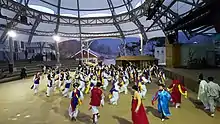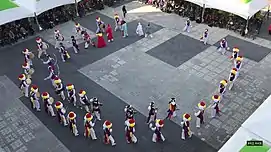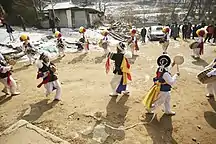Imsil Pilbong nongak
Imsil Pilbong nongak(한국어 : 임실필봉농악) is a type of Korean folk music (pungmul-nori) from Pilbong-ri, Gangjin-myeon, Imsil-gun, North Jeolla province.[1] It was designated as No.11-5 asset of the Important Intangible Cultural Property by the South Korean government.[2] It was added to the UNESCO intangible cultural heritage list on November 27, 2014. It passed on the tradition of Honam-jwado nongak and was made famous by Yang Sun-yong (Hangul: 양순용; Hanja: 梁順龍, 1994–1996)[3]



History
Pilbong Nongak was made by Park Hak-sam[4] from Lee Hwa-chun[5] who was a famous performer of kkwaenggwari at that time.[3] Since then, Song Ju-ho[6] and Yang Soon-yong[7] have developed further.[3] It was designated as No.11-5 asset of Important Intangible Cultural Property by the South Korean government in 1989.[3] Yang Soon-yong is the sang-seo[8] (of Philbong-gut until his death, his son Yang Jin-sung followed.)[9]
Features
The characteristics of Imsil Pilbong nongak, unlike other nongak, are:
- regular intervals from ilchae[10] (one strike) to chilchae[10] (seven strike).[11]
- performers perform movements as they play to increase their excitement, revealing their artistic qualities.[12]
- the second half of a nongak performance shows a series of shamanistic and artistic performances with different people who do not play.[12]
Types
In Pilbong village,「Madang-Balbgi(마당 밟기)」is performed on the first day of the year (eong-cho),Ma-gut[13](매굿)」which is performed on the last day of the year (Sugdal-gumum), 「Dang san-je[14](당삱c is played for nine days on Jeong-wol, 「Nodi-gosa gut(노디고사굿)」. It is performed on the fifth day of Borum「Gulgung-gut(걸궁굿)」, which is performed when visiting other villages for money or grain, 「Durae-gut(두레굿)」 for summer farming, etc.[15]
Performance
Seo(kkwaenggwari) Chibae
The performer wears a black half-sleeved outer called Duguri with the end retail named Saek-dong.[15] A gold and red cloth is inserted in the back using two pins, attached like wings, with a blue band around the waist. The costume is completed by a top hat and a white crane fur called ‘Bu-po’.[16][17][8]
Janggu Chibae
The performer wears a blue vest on a white pants.[8][15] A yellow cloth sits on the left shoulder and a red cloth on the right, with a blue cloth on the waist. The head carries a towel and a flower hat.[15] The best performer is Sang-Janggu.[17] Unlike Honam-udo nongak, one or more Janggu chibae of Honam-jwado plays Sul-Janggu’ in combination.[9][18]
- Buk Chibae
The performer wears a blue vest on a white pants.[15] A yellow cloth sits on the left shoulder and a red cloth on the right, with a blue cloth on the waist. The head carries a towel and a flower hat.[15] Buk Chibae makes a big sound and helps the sound of Janggu.[9][8]
Jing Chibae
The performer wears a blue vest on a white pants.[15] A yellow cloth sits on the left shoulder and a red cloth on the right, with a blue cloth on the waist. The head carries a towel and a flower hat.[15] Jing Chibae creates an mood by making a long, loud sound.[17][8]
Sogo Chibae
The performer wears a blue vest on a white pants. A yellow cloth sits on the left shoulder and a red cloth on the right, with a blue cloth on the waist. The head carries a towel and a flower hat.[15] Sogo Chibae is the main character of Pilbong-gut. They have fun playing and dancing to make Pangut look diverse and lively.[17][8]
Chae-Sang Chibae
The performer wears a blue vest on a white pants.[15] A yellow cloth sits on the left shoulder and a red cloth on the right, with a blue cloth on the waist.[15] The hat is called ‘Chae-Sang’ and attaches a long paper line that spins it. (Hodli, who was a mascot for the 1988 Olympics, wore it on his head.) Splendid movement makes the Pangut dynamic.[15][8]
Jap-sek
The actors and other performers featured in Imsil Pilbong Nongak include the lead actor (hunter, daeposu), male clown or shaman’s husband (changbu), monk, nobleman (yangban), child apprentice to the lead gong player (nonggu), new bride (gaksi), flower boys and girls (hwadong).[17][8] In some of the quieter acts these actors play the leading role.[17] They are all free to move around the Pan-gut, making the Pan-gut dynamic with jokes, gestures, and dancing, and become a bridge between performers and audiences.[17]
Sequence
The Pan-gut[19] of Imsil Pilbong nongak is divided into the front and back part.[15] The first part consists of music of starting gut,[19] gilgut,[20] chae-gut,[21] hohu-gut,[22] pungryu-gut.[23] The back part consists of three-'bangowljin,[24] misigi-youngsan,[25] gajin-youngsan,[26] chum-gut (dol-gut),[27] subakchigi,[28] etc.[15]
Notable performers
The leader of the Imsil Pilbong nongak is called a sangseo.
See also
- Pungmul
- Namsadang
- Pyeongtaek nongak
- Samul nori
- Traditional music of Korea
References
- "국가문화유산포탈 | 문화재 검색". www.heritage.go.kr. Retrieved 2019-06-13.
- 이, 재순 (2009-09-17). "푸진 굿, 푸진 삶 '임실필봉농악'따라 배우기 | 보도/해명 상세 - 문화재청" [english title goes]. www.cha.go.kr. Retrieved 2019-06-13.
- <필봉농악의 계보학적 해독과 풍물굿 전승론>, 전지영, 한국음악사학회, 2018년 12월
- "호남 좌도 임실필봉농악 홈페이지에 오신걸 환영합니다". pilbong.co.kr. Retrieved 2019-06-17.
- "호남 좌도 임실필봉농악 홈페이지에 오신걸 환영합니다". pilbong.co.kr. Retrieved 2019-09-24.
- "호남 좌도 임실필봉농악 홈페이지에 오신걸 환영합니다". pilbong.co.kr. Retrieved 2019-09-24.
- "호남 좌도 임실필봉농악 홈페이지에 오신걸 환영합니다". pilbong.co.kr. Retrieved 2019-09-24.
- "호남 좌도 임실필봉농악 홈페이지에 오신걸 환영합니다". pilbong.co.kr. Retrieved 2019-09-24.
- <풍물굿의 가락 구조와 역동성>, 이종진, 안동대학교대학원, 1996
- "호남 좌도 임실필봉농악 홈페이지에 오신걸 환영합니다". pilbong.co.kr. Retrieved 2019-09-24.
- <관악풍물패연합여름전수자료집>, 관악풍물패연합, 2005
- <풍물굿에서 춤의 기능과 미학적 작용>, 양옥경, 2011
- "호남 좌도 임실필봉농악 홈페이지에 오신걸 환영합니다". pilbong.co.kr. Retrieved 2019-09-24.
- "호남 좌도 임실필봉농악 홈페이지에 오신걸 환영합니다". pilbong.co.kr. Retrieved 2019-09-24.
- "임실필봉농악", 위키백과, 우리 모두의 백과사전 (in Korean), 2019-05-11, retrieved 2019-06-13
- 국립민속박물관. "상모놀이". 한국민속대백과사전 (in Korean). Retrieved 2019-09-24.
- <호남좌도풍물굿>, 필봉농악, 전주, 1991
- 국립민속박물관. "설장구놀이". 한국민속대백과사전 (in Korean). Retrieved 2019-09-24.
- "호남 좌도 임실필봉농악 홈페이지에 오신걸 환영합니다". pilbong.co.kr. Retrieved 2019-09-24.
- "호남 좌도 임실필봉농악 홈페이지에 오신걸 환영합니다". pilbong.co.kr. Retrieved 2019-09-24.
- "호남 좌도 임실필봉농악 홈페이지에 오신걸 환영합니다". pilbong.co.kr. Retrieved 2019-09-24.
- "호남 좌도 임실필봉농악 홈페이지에 오신걸 환영합니다". pilbong.co.kr. Retrieved 2019-09-24.
- "호남 좌도 임실필봉농악 홈페이지에 오신걸 환영합니다". pilbong.co.kr. Retrieved 2019-09-24.
- "호남 좌도 임실필봉농악 홈페이지에 오신걸 환영합니다". pilbong.co.kr. Retrieved 2019-09-24.
- "호남 좌도 임실필봉농악 홈페이지에 오신걸 환영합니다". pilbong.co.kr. Retrieved 2019-09-24.
- "호남 좌도 임실필봉농악 홈페이지에 오신걸 환영합니다". pilbong.co.kr. Retrieved 2019-09-24.
- "호남 좌도 임실필봉농악 홈페이지에 오신걸 환영합니다". pilbong.co.kr. Retrieved 2019-09-24.
- "호남 좌도 임실필봉농악 홈페이지에 오신걸 환영합니다". pilbong.co.kr. Retrieved 2019-09-24.
- "호남 좌도 임실필봉농악 홈페이지에 오신걸 환영합니다". pilbong.co.kr. Retrieved 2019-09-24.
- "호남 좌도 임실필봉농악 홈페이지에 오신걸 환영합니다". pilbong.co.kr. Retrieved 2019-09-24.